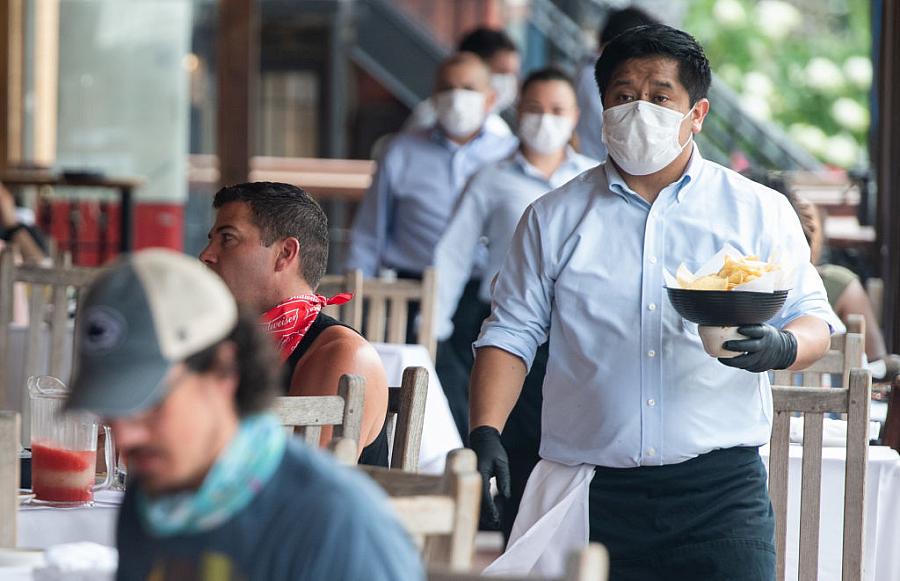With cases surging and aid running out, workers face 'impossible choices'

(Getty Images)
Within hours of the shelter-in-place orders this spring, house cleaners across the country received text messages from clients cancelling future jobs.
Now, those same workers — many whose immigration status precluded them from receiving federal relief — are deciding whether to return to work in their clients’ homes and risk their health in the process.
“As states are reopening their economies, domestic workers are experiencing the crisis of impossible choices,” said Haeyoung Yoon, senior policy director at the National Domestic Workers Union, in this week’s Center for Health Journalism Covering Coronavirus webinar.
Amid a backdrop of soaring coronavirus cases, the country’s workforce is increasingly weighing a return to work against the health risks involved. Low-income and immigrant workers face particularly dire predicaments. Yoon joined New York Times reporter Jim Tankersley and Dr. Jan Gurley, director of San Francisco’s Public Health Emergency Preparedness and Response, to discuss the country’s economic trajectory, the struggles of low-wage domestic workers, and how journalists can better tell the stories of these difficult choices.
Where we stand
In recent months, the U.S. economy has gone through the experiences of a typical recession in “fast motion,” said Tankersley, who writes about economics and tax policy.
In March, the shutdown quickly pushed the country into recession. In April and May, the economy started to come back as states began lifting restrictions. But, in June, the reopening stagnated, and, most recently, the economy has started to contract again as cases grow and people again limit their activities, regardless of government policies.
“The virus is dictating a lot of the economic activity we see,” Tankersley said.
He described the government’s “extraordinary” fiscal support: $3 trillion in aid to keep the economy afloat, including checks to individual families, expanded unemployment benefits and a variety of aid to businesses. As this aid runs out, it’s unclear what will happen next. One theme that’s emerged, though, is that communities of color and women have been hit the hardest during the pandemic, he said, referring to the economic shock
Balancing work and health
Another group that has been disproportionately impacted: immigrants without legal status, who were excluded from the federal relief package, a decision that has had “an enormous impact” on low-wage working families, Yoon said.
“The profound ways people are falling through the cracks are really real,” she said. “We’re all weathering the storm of coronavirus, but not everyone is getting the support and assistance they need to really survive through this so that our economy can function again.”
With the country reopening, domestic workers such as nannies, house cleaners and in-home caregivers are facing tough decisions, Yoon said. For example, rehired nannies are likely eager to earn a paycheck again — especially if they have had no financial safety net — but they are also concerned about their own and their family’s health as they work closely with others in someone’s home.
One source of protection against COVID-19 is clear information and guidance, said Gurley, an internal medicine doctor who works for the San Francisco Department of Public Health. But even though there’s a vast patchwork of information out there, many workers don’t know about local guidelines or the rationale behind them.
San Francisco does offer specific guidelines for areas such as house cleaning, suggesting that all residents be out of the house and windows be kept open.
Telling real people’s stories
There’s a point in the human mind where the difference between 100,000 and 130,000 deaths becomes hard to grasp, Gurley said. That’s why it’s especially important to put a face on these tragedies to “really grip the public consciousness.”
For example, ask someone how their small cleaning business is staying safe while working in people’s homes. Reporters could also look at what specific guidance is being offered in their city or county and whether workers are aware and able to follow this advice.
Yoon also suggested telling the personal stories, such as home care workers and their struggle to stay safe as they work closely with elderly clients. How do you practice social distancing when have to bathe your client? More broadly, reporters should explore the financial suffering of domestic workers who lost all their income yet did not qualify for federal relief.
Tankersley advised reporters to focus on the local, while still linking that with the national, adding “the local level is a gold mine of good stories.” For example, describe the high stakes in educational decisions that represent the confluence of public health and the economy. If you send kids to school, you risk infection spread that could jeopardize the health of teachers, yet keeping kids home presents a barrier for working parents.
On the economic front, he suggested reporters examine pandemic-related job losses that end up becoming permanent. Who are the workers whose jobs have been lost for good? Which companies might not ever reopen? What does that mean for the community?
Look at state and local budgets and dig into the broad social impacts of lower tax revenues. Reporters can also look at which businesses in their community received government aid and which didn’t. You might see some surprises. Did people who need it get the funds or did people who didn’t need it take it? Stories abound.
**
Watch the full presentation here:

